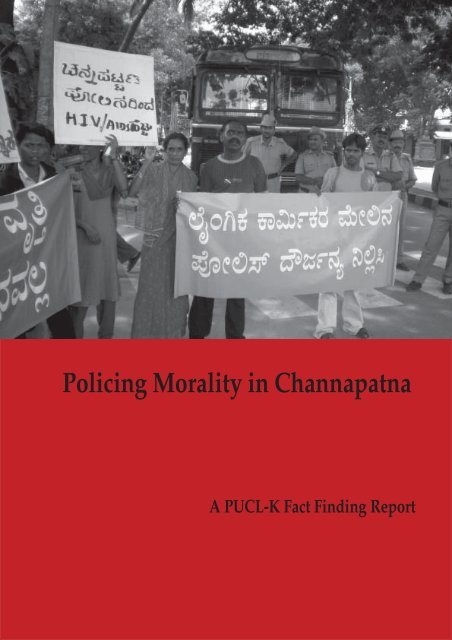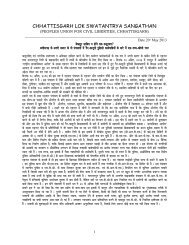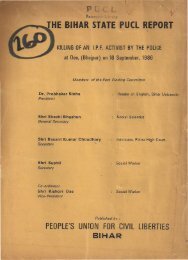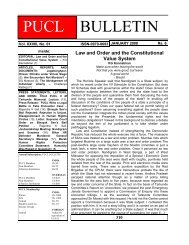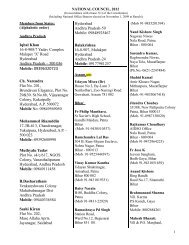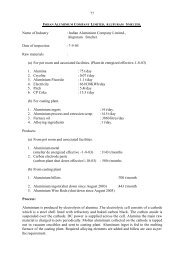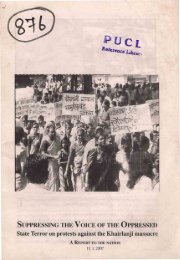Full report (pdf) - People's Union for Civil Liberties
Full report (pdf) - People's Union for Civil Liberties
Full report (pdf) - People's Union for Civil Liberties
- No tags were found...
Create successful ePaper yourself
Turn your PDF publications into a flip-book with our unique Google optimized e-Paper software.
Policing Morality in ChannapatnaA PUCL-K Fact Finding Report
ContentIntroduction............................................................................................................................................... 3Background and Context ......................................................................................................................... 3Events of 2nd June 2007 ........................................................................................................................... 4The aftermath of the arrest on 2nd June 2007 ...................................................................................... 6The events of 3rd June 2007 .................................................................................................................... 7Testimonies of violence ........................................................................................................................... 8Response of the Police ............................................................................................................................. 9Response of TV9 ..................................................................................................................................... 10Response of KHPT.................................................................................................................................. 10Conclusions ............................................................................................................................................. 11Recommendations .................................................................................................................................. 13Annexure 1 .............................................................................................................................................. 14Annexure 2 .............................................................................................................................................. 16Annexure 3 .............................................................................................................................................. 17Annexure 4 .............................................................................................................................................. 18Annexure 5 .............................................................................................................................................. 26PUCL-KA Report of PUCL-Karnataka, 2007
IntroductionThe series of disturbing events inChannapatna (http://www.channapatnacity.gov.in) commencedwith the arrest on 2 June 2007 of four womenunder the Immoral Traffic (Prevention) Act,1956 and the consequent media exposure andtrial of these women. When a public protestwas held to condemn the police complicity inconverting what should have been a routinejudicial process into a sensational trial bymedia, the protest was wilfully disruptedwith the protesters being beaten up in thevery presence of the police by anti–socialelements. These events constituted adisturbing pattern of state moralism andauthoritarianism wherein all democraticmeans of expressing a political opinion weresought to be stifled. Being deeply concernedabout this flagrant violation of the basicrights guaranteed in our Constitution to allcitizens, the People’s <strong>Union</strong> For <strong>Civil</strong><strong>Liberties</strong>-Karnataka (PUCL-K) constituted afact-finding team which comprisedrepresentatives from human rights groups,lawyers groups, Dalit groups, unorganizedworkers as well as health groups to enquireinto the above mentioned incidents. The factfindingteam consisted of Ramdas Rao, Salmaand Geeta from the PUCL-K (www.pucl.org),Divya Veerabhadra from Lawyers’ Collective(www.lawyerscollective.org), Yashoda fromKarnataka Dalita Mahila Vedike (KarnatakaDalit Women’s Forum), Arvind Narrain andAarti Mundkur from Alternative Law Forum(www.altlaw<strong>for</strong>um.org), Jayaram fromGarment and Textile Workers <strong>Union</strong>, andVinay from Janarogya Andholana Karnataka(People’s Health Movement, Karnataka –http://phmindia.org/states/karnataka/index.html).On 8 June 2007 the fact-finding team spoke tothe women who were arrested under theImmoral Traffic Prevention Act 1956 (ITPA),the protesters in the dharna who were beatenup, the Dy. S. P Halesh Naik and theprobationary Dy. S. P. Devraj, the SPBangalore city, representatives of civil societyorganizations in Channapatna such asSpandana (a women’s rights initiative) andKarnataka Rajya Raitha Sangha (KRRS –Karnataka State Farmers Association) inorder to determine if and how the basicrights guaranteed to all citizens have beenviolated in the case of women in sexwork.Background and ContextChannapatna is a small town located sixtykilometres from Bangalore on the Bangalore-Mysore highway. It has traditionally beenknown <strong>for</strong> its wooden lacquered toys andproducts. In terms of its social history,Channapatna’s farming communities havebeen vocal and active members of theKarnataka Rajya Raitha Sangha. It has alsohad an un<strong>for</strong>tunate history of communalskirmishes between Hindus and Muslims,which erupted in a major clash in 1990 inwhich over 18 people died.Another social concern which has emergedwithin recent years in the Channapatnacontext is the spread of HIV. Due to its beingon the highway route and having asignificant migrant and mobile population ithas emerged as a significant node <strong>for</strong> thespread of HIV. As per statistics of theNational Aids Control Organisation (NACO– http://www.nacoonline.org) in 2006 with apopulation of almost 55 million, Karnatakahas one of India’s worst AIDS epidemicswith an estimated 500,000 people orapproximately 1.7% of the adult populationliving with the disease. By comparison,India’s national HIV prevalence is 0.9% ofthe adult population. Annual SentinelSurveillance data indicates that Bangalorerural district under which Channapatna fallshas an even higher HIV prevalence rate of2.5% of the adult population.3
Channapatna, which mirrors the situation inthe rest of Karnataka which has a highprevalence of HIV has many of theconditions which result in the rapid spreadof HIV i.e. poverty levels are high, a largenumber of people surviving on sexwork;literacy levels are low; and a long history ofmigrant labour with a number of peopletravelling daily to Bangalore City <strong>for</strong> work.The concern around the spread of HIV inChannapatna led to the establishment of aproject to address HIV and AIDS issuesfocusing on women sexworkers and othervulnerable populations in 2004 by Suraksha,an NGO working with sexworkers, sexualityminorities and slum populations inKarnataka on health, livelihoods and humanrights issues.The work of Suraksha since 2004 inChannapatna has had two broad prongs.Firstly, there has been a focus on rights-basedwork to create an enabling environment <strong>for</strong>women in sexwork. This has involvedencouraging processes of communitymobilization, collectivization, intervening incrisis situations as well as organizing publicprotests and rallies demanding thatsexworkers rights be respected. Secondly,Suraksha has focused on service delivery, byenlisting the services of women in sexwork(known as Community Mobilizers/PeerEducators) in order to identify all sexworkersin the town, and promoting condom usageamong them using various methods.Suraksha works in seven talukas inBangalore Rural District and Channapatnataluka is considered one of the mostsuccessful of the taluk level HIV and AIDSinterventions.Suraksha’s method of working has beenfairly non-controversial with the generalpublic having little knowledge of whatexactly the organization does. In factinterviews with Ms. Sita from Spandana andMr. Laxman and Mr. Puttanna from theKRRS revealed their complete lack ofknowledge or awareness about theorganization’s activities. HoweverSuraksha’s activities came under the publicscanner with the events, which unfolded on 2June 2007.Events of 2nd June 20074The police version:According to the police version, based onin<strong>for</strong>mation received, the ProbationaryDy. S. P., Devaraj, along with two womenconstables and two other officers, conducteda surprise raid on the house of Radhika inMathikere village near Channapatna. Thisraid was conducted in the presence of twopanchayat members from Mathikere Village.On entering the house they found bothwomen and men engaging in ‘immoral’activities. The arrested included four womenand three men who were taken to the policestation, and cases registered against themunder Sections 3, 4, 5 and 7 of the ITPA. Thearrested were Chikkatayamma,Chandramma, Chandrakala, Shantamma andthree other men.As per Mr. Devraj’s version, the arrest wasconducted with proper in<strong>for</strong>mation andwhen they conducted the raid it was foundthat men and women had locked themselvesin the rooms and there were packets ofNirodh (Government-provided freecondoms) under the beds and pillows.Subsequent to the arrest, the accused weretaken to the Channapatna police stationwhere curious onlookers had gathered andthere were many people including mediarepresentatives within the police station.According to Mr. Devraj, there were both TVand press persons who withoutauthorization took video shots of the arrestedwomen from just outside the police station.They were then produced be<strong>for</strong>e theMagistrate who remanded them to judicialcustody.
Following the raid the Probationary Dy. S. P.stated that some of the accused revealed thatthey worked at Suraksha and so theProbationary Dy. S. P. immediately went tothe Suraksha office where without a searchwarrant he conducted a search of thepremises. Finding nothing after a cursoryexamination of the records of Suraksha,which included confidential in<strong>for</strong>mation ofsexworkers including their area of residence,area of operation, health status, he left thepremises.The version of the arrested women.We briefly reproduce the statements by thearrested women on the events of the 2ndJune, 2007.Chikkathayamma (Drop-In-Centre (DIC)Supervisor at Suraksha): I have been incharge of condom distribution and HIVtraining <strong>for</strong> 3 years at Suraksha. I am 40 yearsold. I contested the village panchayatelections and won as an independent, andwas working as a gram panchayat member. Ihave lost the elections <strong>for</strong> village panchayatpresident once earlier. I would have beenelected president this time.Radhika and I were close friends. I went toher house to collect money <strong>for</strong> an officialfunction of Suraksha. Radhika’s neighbourshaven’t complained about us be<strong>for</strong>e; it musthave been others in the town. During theraid, 2 men and 4 women were arrested, andproduced be<strong>for</strong>e the magistrate at 11 p.m.During the raid, we women were shouted atby the police but they beat up the men. Wewere in judicial custody <strong>for</strong> 7 days. We weretreated well in Central Jail. We haven’t donesexwork in the house. Everyone knew aboutmy work <strong>for</strong> Suraksha and praised me.The newspapers have <strong>report</strong>ed that we werefound naked with men in the bedrooms. Thisis simply not true. All this publicity willdestroy me, what’s the use of living afterthis? I wanted to commit suicide, but when Ifound that Suraksha had staged a dharna <strong>for</strong>us, I decided not to. I was shattered andgrief-stricken in jail. I want to fight <strong>for</strong> justicesince I haven’t done anything wrong.Chandrakala: I am 26 yrs old, and am aresident of Channapatna. Chandrammabrought me to Suraksha to seek somemedical help. On that day, we reachedRadhika’s house in the afternoon and werechatting <strong>for</strong> about 10 minutes be<strong>for</strong>e thepolice raid at 2.45 p.m. There was Preethi,(Radhika’s daughter), 2 small children,Chandramma and Chikthayamma and hersister. Two men came and stood outside thehouse discussing some financial matter. Soonafter they left, the police descended on usfrom all sides. They pounced on one of themen who had come in a car and was talkingto Chandramma, and beat him up badly. Thepolice took us to the police station; theydidn’t produce any warrant. They draggedthe women out of the house. There were 2women inspectors and a number ofpolicemen.In Channapatna, from the moment westepped down from the jeep, they startedshooting pictures. People were also let in,they all took pictures of us. We were seatedon the bench, and the TV camera man tookpictures.I don’t know if my aunt with whom I’mstaying will let me back into her home, nowthat I’ve been subjected to public exposure.She might, though, <strong>for</strong> the sake of my 2children. I’d like to take up work atSuraksha. I will seek Suraksha’s help andface the world.Shanthamma ( Community Mobilizer atSuraksha): I’m 31 years old, a resident ofChannapatna and I live with my mother. Myhusband was a policeman who wasdischarged after 8 years of service due to hisalcoholism. I have left him, and I have 4children, 2 girls 19 and 17, one of whom ismarried, and a 14 year old son. The secondgirl works in a garment factory. At Suraksha,I provide in<strong>for</strong>mation about HIV tosexworkers, and I bring poor people to theclinic <strong>for</strong> treatment. On that day I came to theoffice at 10.30 and left <strong>for</strong> the field to make5
preparations <strong>for</strong> the official function. Mysister, Chikthayamma, and I went toRadhika’s house. We were four women andone man present and were chatting on theveranda when the police raided the house.The policemen surrounded the house fromall sides. There were 2 policewomen and anumber of policemen. They arrested uswithout in<strong>for</strong>ming us as to why we weretaken to the police station. At the station, ourphotos were taken and the police refused totell us why we were arrested. The policeprepared the charge sheet and took us to themagistrate at 11 p.m. From there we weretaken to Central Jail. We kept asking themwhy we were arrested but they didn’t tell usanything. They didn’t serve us any food orrefreshments from the time of our arrest tillwe reached Bangalore at 2 a.m. We have beentold by Suraksha about possible arrests inlodges when we go <strong>for</strong> condom distributionbut this was a friend’s house, not a brothel.There is no brothel in any village. I’mworried about going back to my house in thevillage and especially about what peoplethere will say as I have grownup children.I’m ready to go back to work. I amdetermined to fight back.Chandramma (Community Mobilizer atSuraksha, Channapatna): I live inChannapatna with my son who is18 yearsold, and works at a bar and has studied up toSSLC. I have lived in Channapatna <strong>for</strong> 15years, ever since my husband left me. I wentto Radhika’s house in connection with ouroffice function. I and Kala went at 2.45 p.m.Chikthayamma and Shantha were there. Itold the police that they would have beenjustified in arresting me if I didn’t have anyclothes on. This arrest was engineered bysomeone who didn’t want Chikthayamma tobe elected panchayat president. In the policestation all kinds of people were let in andallowed to take pictures and make fun of us,but the staff of Suraksha was kept out. Wewere not afraid when the police arrested usbut we got afraid when we saw peopletaking our pictures. We were made to sign onFIRs, taken to a magistrate and we thoughtwe’d be released after paying a fine, but wewere brought to the jail. The magistrate wasa woman. People of my village heard aboutmy arrest and came to look at me, and toldother people back in my village. My son hasreassured me and asked me to fight back. I’mafraid my husband’s family might denyproperty rights to my son after this case.This attack is the first of its kind inKarnataka. It is wrong to say that I wasdoing sexwork in Radhika’s house. We haveto fight <strong>for</strong> justice, we can’t let them get awaywith this.The aftermath of the arrests on 2nd June 20076Suraksha, as has been noted be<strong>for</strong>e, had notreally been in the public eye in Channapatna.Further, even women in sexwork, the groupwith which Suraksha worked most closely,had not really been the targets of any seriouspolice action. The police according toSuraksha staff used to be broadly supportiveof Suraksha’s work. The equilibrium whichhad been worked out in Channapatna wassuch that police action rarely meant theregistration of a case under the ITPA.Hence it was definitely a new development<strong>for</strong> the police to register a case under theITPA and that too when three of the fourwomen accused were employees ofSuraksha. The veracity of the caseregarding whether the women were indeedguilty of running a brothel or living off theearnings of a prostitute should necessarily bedecided in a court of law. However, whattook the matter beyond the purview of thejudiciary into the court of public opinion wasthe complicity of the police in allowing themedia ( both print and television) to capturethe arrest of the accused and in effectpronounce them guilty be<strong>for</strong>e the judicialprocess could commence.
There was media coverage with headlinessuch as ‘Suraksha caught in the net ofprostitution’ (Vijay Karnataka, 04.06.07) and‘Prostitution in the name of AIDSPrevention’ (Prajavani, 04.06.07). Photos ofthe arrested women were splashed acrosssome of the newspapers (Police Story,24.06.07). In addition two TV channels, TV9and E TV Kannada carried short clips of thearrest of the women in which their faceswere fully shown. In effect, regardless of thefinal judicial decision, the women throughthe media coverage were stigmatized assexworkers in the larger community.Suraksha being seriously concerned aboutthe implications <strong>for</strong> women sexworkers inChannapatna and their work of the fall out ofthe police action decided to organize a publicprotest the very next day. In the reasoning ofthe Suraksha’s Executive Director, ElavarthiManohar, the decision to protest was basedon the fact that women sexworkers have thehistory of organizing a successful publicrally and public meeting in Dodballapur(Bangalore Rural District) already. He feltthat a show of strength was necessary fromSuraksha’s end to stop police harassment ofwomen sexworkers and Suraksha, to buildup public opinion against the illegal policeactions and to let the women in jail knowthat they still had the support of theorganization. The issues Suraksha wasconcerned about were the complicity of thepolice in allowing the media to cover thearrest with no regard <strong>for</strong> confidentiality, thesalacious media coverage as well as theillegal police intrusion into Suraksha office.Suraksha along with allied organizationsdecided to organize a protest on 3 June 2007outside the Channapatna Police Station.The Events of 3rd June 2007Staff and community members associatedwith Suraksha, Karnataka Sexworkers <strong>Union</strong>(independent Trade <strong>Union</strong> of sexworkers inKarnataka), Sangama (Organizationdefending the human rights of sexualityminorities), Samara (Communityorganization of sexworkers and sexualityminorities in Karnataka), Sadhane(Organisation of sexworkers and sexualityminorities living with HIV), LesBiT(Community initiative of lesbian/bisexualwomen and Female-to-Male transgenderindividuals) and Sanchaya Nele (Dalitfeminist organization)went to Channapatnafrom Ramanagaram. The understandingamong the protesters was that four womenincluding three Suraksha employees werearrested by the police and that they wereexposed to public ridicule in the media. Thisset the context <strong>for</strong> the dharna.The group of around 100-140 people gotdown in the bus stand and went withplacards and banners in an orderly fashiontowards the Channapatna Police Station.Right from the bus stand onwards the groupwas accosted by the police who kept askingthe members of the group about why theywere protesting. The police were told to askElavarthi Manohar, the Executive Director ofSuraksha.The placards the group carried had sloganssuch as ‘My body, my right’ , ‘Sexwork isnot wrong’, ‘ Stop violation of the rights ofsexworkers’, ‘Sexworkers rights are humanrights’, ‘Repeal ITPA’, ‘Channapatna Policeare responsible <strong>for</strong> rise in HIV and AIDS’,‘Sexwork is dignified labour - We givepleasure <strong>for</strong> money’ etc.When the group reached the police station,they stood outside the station on a serviceroad with the placards and started shoutingslogans. The group of 100-140 people werenot obstructing traffic and were not causinginconvenience to the public. However,throughout the duration of the protest thepolice were attempting to dispell theprotesters, telling them that they had no7
permission to hold the protest. The protesterswere told to go and talk to the police and tostop shouting slogans. After about 20minutes of the protest Inspector Anandin<strong>for</strong>med Geeta (General Secretary ofKarnataka Sexworkers <strong>Union</strong>) that thepolice would not be able to protect them.And that if they did not stop, the publicwould come and start shouting slogansagainst them.Suddenly around twelve noon, a group ofmen in plainclothes rushed towards thegroup from all directions and startedroughing them up and tearing away thebanners and posters. The protestingassembly was broken up, and the protesterswere chased all the way to the bus stand. Thepolice <strong>for</strong> the most part stood by passivelywatching this roughing up and assault. In thecourse of this assault numerous peoplesuffered grievous injuries. Four of theprotesters had to be treated in BowringHospital, Bangalore and a medico-legal casewas registered in those incidents. Wereproduce below some of the testimonies ofthose who were assaulted.Testimonies of violence8Geeta (General Secretary of KarnatakaSexworkers <strong>Union</strong>): I was hit from the backand hit by a police lathi twice. A policemanalso hit me with his hand. As I was runningaway, I was followed by the goondas and Iwas sexually abused by these men even asthey continued to abuse and rough me up.As I ran, my hair and blouse was pulled andthe goondas put their hands where they arenot supposed to. They threatened to put acidand petrol on me. The police instead ofgiving us protection allowed this beating tohappen. On reaching Bangalore I went toBowring Hospital and got a medical <strong>report</strong>done.S. Gayatri (Samara): The goondas suddenlystarted attacking us even as the dharna wasgoing on and told us that they will throwacid on my face. They chased us all the wayfrom the police station to the bus stand andkept roughing me up and aggressivelyasking me with what permission I had comehere and threatening to beat me. They saidthat we were spoiling all areas and now wewere trying to spoil Channapatna as well.Rangeela (Field Supervisor, Suraksha): Oncethe goondas started attacking us the policeplayed an active role in directing thegoondas to beat us. The police would tell thegoondas see they are going in that direction,go and beat them. The police did not doanything to protect us. Even as we wererunning away, the goondas stopped the bus,pulled us out and beat us. I was sexuallyabused by the goondas who touched me inplaces where they should never have puttheir hands. This was highly insulting andhumiliating.Meena: The goondas were particularlyincensed by the slogan of ‘My Body, MyRight’. They kept shouting at us saying,‘Who are you to shout my body my right?’They said, ‘Go and do work in a factory youprostitute.’ I was abused using even worselanguage and they threatened to remove mysari and beat me and then I would knowwhat my body is and what my rights are.Narayanamma (Suraksha DIC Supervisor):Our aim is to help women from ourcommunity who are in trouble. While wewere shouting slogans I observed that thepublic was with me. I never anticipated thiskind of attack as there never was such aresponse to a public program be<strong>for</strong>e. Therowdies went in to the police station andspoke to the police be<strong>for</strong>e coming out andattacking us. They abused us calling usprostitutes and beat us. I was beaten on myhands and my back. Even though there weremany men in the rally it was the women whowere specially targeted by the goondas. Evenafter we were chased back to the bus stand
and as we boarded the tempo to take us backto Bangalore we were chased by the goondasin another vehicle.Kala (Community Mobilizer, Suraksha): Iwas hit on the head and fell down and lostconsciousness. I was also beaten badly onthe leg, hand and head. I can’t walk properlyeven now. My nose is bleeding and I can’t liftmy hand. My leg is swollen. Due to thebeating on the head I lost consciousness andonly recovered consciousness in BowringHospital. The police instead of stopping thegoondas encouraged them to take us awayfrom the vicinity of the police station andbeat us.Lalita (community member): The police whowere in uni<strong>for</strong>m beat me twice with a lathi.They abused me calling me a prostitute andasking why I wanted justice. When I got tothe bus stand and climbed into a busgoondas came and beat me and made me getdown from the bus. Both the bus conductorand driver did nothing to stop them.Response of the PoliceIn the interviews with Mr. Halesh Naik (Dy.S. P) and Mr. Devraj (Probationary Dy. S. P)both noted that the arrest of the women wasbased on proper in<strong>for</strong>mation and that thearrest was as per law. Mr. Halesh Naik wasnot present at the time of the incident. Mr.Devraj was the key person present both atthe arrest under the ITPA on 02.06.07 as wellas the subsequent rally.On being questioned about the TV <strong>report</strong>sand the pictures that were taken inside thestation the officers denied the fact that theyhad given in<strong>for</strong>mation to TV and press<strong>report</strong>ers so that they could cover the arrestand also denied that they had givenpermission to TV9 <strong>report</strong>er to take pictures ofthe accused inside the police station. Theysaid that TV9 channel have very goodequipments that they can zoom in and shootany pictures in any angle and the same hadhappened that day. Reporters had shot thepictures from outside the police station. Thephotography was unauthorized. Mr. HaleshNaik says that the police station is a veryopen structure and that any Tom, Dick andHarry could see what is going on inside thestation and the same had happened on theday the incident occurred. They concededthat the media coverage should not havehappened in the way that it did, but insistedthat they were unable to prevent it as all theshooting happened from outside the PoliceStation.On being questioned as to why the Surakshaoffice was entered and confidentialdocuments examined without a searchwarrant, Mr. Devraj denied that a search hadbeen conducted or any documents seized. Hereiterated that he cursorily examined a fewfiles lying on the floor and finding nothing,he left. He also noted that since the officewas a public place there was no need <strong>for</strong> asearch warrant. According to him the onlypurpose <strong>for</strong> going to the office was to search<strong>for</strong> two people who ran away just after theincident of 02.06.07 saying that they wereworkers of Suraksha.On being questioned about why the goondaswere not controlled and why an unarmedpeaceful crowd was allowed by the police tobe beaten up, the officers responded bypointing out to certain proceduralirregularities on the part of the protestorganizers. According to them Suraksha hadnot given a requisition letter with regard tothe protest thereby, it was a lapse on theirpart. The police officials were not aware ofthe whole protest and thereby failed to giveproper protection.Mr. Devraj also noted that people in ruralareas have a stigma and discriminationagainst sexwork and especially, brothels inresidential areas. The rally was seen assupporting sexwork in rural areas whichaccounted <strong>for</strong> people getting agitated. Whatmade things worse were the highly9
provocative slogans and placards used by theagitators such as “Nanna Deha NannaHakku” (My body, my right) . This resultedin a section of the public taking matters intotheir own hands and assaulting theprotesters. When this happened the policedid their best to control the situation in thecourse of which some people might havebeen injured.On being questioned as to how they wereunable to control what was in effect an attackon unarmed and non-violent protesters andmaintain law and order which was theirprimary responsibility. On being asked whythey failed to ensure that women were notprotected from assault and serious hurt, Mr.Halesh Naik’s only response was to say thatpolice aggressively act to control situations,sometimes there is inaction by the police andsometimes mistakes happen as police arealso human beings.Response of TV9The team could not meet Nagaraj, the<strong>report</strong>er of TV9 but was able to speak to himover the phone. When we asked him abouthow did he get the in<strong>for</strong>mation about theraid, Mr. Nagaraj said that day he had beento the town and he received a phone callfrom some villager who said that there is araid going on in Shettarahalli. Thereby hethought it would be interesting to go andtake some photographs. He said since he wastoo far from the place of the incident, hethought he would directly capture on filmthe arrested persons in the police station.When he was questioned as to who allowedhim to go inside the station to film, he saidpolice themselves gave permission to enterthe station, along with his cameraequipment. When he was asked as to howhe could telecast the faces in the newswithout blanking out the faces of the(women), the <strong>report</strong>er agreed that it was alapse on his side and it had happenedaccidentally and it was not intentional.This was corroborated by Somashekhar,news editor of the Bangalore desk of TV9 ,who admitted that though it is theestablished policy of their channel to blankout the faces of women and children whoare accused in a criminal incident, the policywas violated in this instance because of themistake of their copy editor, working underpressure of deadlines. Somashekhar said thatthe copy editor was reprimanded.Response of KHPT10The team also decided to meet those whowere funding Suraksha’s HIV/AIDS ef<strong>for</strong>ts ,i.e. the Karnataka Health Promotion Trust(KHPT).Our team expressed its concern to officials ofKHPT about the confidential in<strong>for</strong>mationcontained in the Sex Workers Register aboutsex workers and their clients, including theirHIV status, maintained by NGOs likeSuraksha, which work on HIV and AIDS .KHPT requires the agencies it funds tocollect such in<strong>for</strong>mation, but in the event ofthis confidential in<strong>for</strong>mation being disclosedto the public, vulnerable women, especiallysex workers in rural areas, would be put toextreme risk. KHPT needs to be concernedabout the human rights implications of suchunauthorized disclosure.Ms. Vandana Gurnani, director of KHPT,clarified that the Sex Workers Register is partof an individualized monitoring system (inaggregate and in individualized <strong>for</strong>m) that isessentially designed “to reach the lastwoman” in an intervention campaign. Such
in<strong>for</strong>mation reaches KHPT in coded <strong>for</strong>m,and KHPT does not share this data with anyindividual or agency. Ms. ParinitaBhattacharjee added that this in<strong>for</strong>mation iscollected only with the consent of the sexworker. However, it was evident that thisconsent was not an in<strong>for</strong>med one, with thesex workers being unaware of the fullrepercussions of such in<strong>for</strong>mation falling intowrong hands. Ms. Parinita conceded that inthe aftermath of the Suraksha case, there is aneed to standardize in<strong>for</strong>mation collectionsystems to prevent recurrence of suchpotential misuse of sensitive in<strong>for</strong>mation.ConclusionsAfter listening to the testimonies of thosewho were arrested on the 02.06.07 as well asthose who were beaten on 03.06.07 as well asthe version of the police, the media andKHPT officials with respect to the twoincidents we have come to the followingconclusions:1. The police have not understood theletter and spirit of the ITPA. The act ismeant to target trafficking and inparticular brothel keepers and thosewho live off the earnings of prostitutionof another person. In the facts of thepresent case as per the police case itselfthere is nothing to indicate that all thewomen arrested are either living off theearnings of the prostitution of anotherperson or that they are running abrothel. There is also a misapprehensionof the very understanding ofprostitution under the ITPA. The ITPAafter its 1986 amendment under Sec 2 (f)understands prostitution as, ‘ the sexualexploitation or abuse of persons <strong>for</strong>commercial purposes and the expressionprostitute shall be construedaccordingly.’ The definition has beenchanged from Section 2(f) of the 1956Act , which understood prostitution as ,‘the act of a female offering her body <strong>for</strong>promiscuous sexual intercourse <strong>for</strong> hire,whether in money or kind and whetheroffered immediately or otherwise andthe expression prostitute shall beconstrued accordingly.’ The crux of thechange in definition of prostitution isthat it is meant to criminalize only thoseactivities where there is sexualexploitation or abuse <strong>for</strong> commercialpurposes. If such a relationship is notpresent, regardless of the nature ofpublic opinion or perception of morality,the police have no business conductingany arrest. This conclusion is furtherbuttressed by a circular issued by theDGP Karnataka State which reiteratesthe point that Sec 3,4,5, and 6 are meantto be used against traffickers, pimpsand other agents and facilitators ofcommercial sexual exploitation ofwomen and children (see Annexure I).Very similar circulars have been issuedby the DGP’s of Tamil Nadu andAndhra Pradesh (see Annexures II andIII). There is also an emerging academicopinion which supports the aboveconclusion. Jacob Punnose the Addl DGof Police, Kerala has noted, ’There arewide differences between moralprecepts on one hand and socialprejudice and enacted law on the otherhand. Being a prostitute is not anoffence as per law but being a prostituteis considered immoral...The law todaypermits the woman to sell privately andthe man to buy it. It prohibits a thirdparty from making money out of it.‘ (seeAnnexure IV).2. To ensure safeguards, the ITPA underSec 15 mandates that when persons arearrested under the ITPA, the SpecialPolice Officer or Trafficking PoliceOfficer may make a search without awarrant only in the presence of tworespectable inhabitants of the localityone of whom shall be a woman.However in the case of the arrests madeon 02.06.07, there was neither a Special11
12Officer making the arrest nor were theretwo respectable inhabitants one of thembeing a woman when the arrest wasbeing made. The Mahazar is signed bytwo male members of the Panchayat butthe arrested women categorically denythat there was anybody else apart fromthe police officers during the arrest. Thefact that there were neither SpecialPolice Officers nor were there tworespectable inhabitants (one of thembeing a woman) makes the mode ofarrest highly irregular.3. Following the incident of 02.06.07, theaction of the Probationary Dy. S. P inentering Suraksha office without asearch warrant and examiningSuraksha’s records is illegal. The policeare not entitled to enter private premisesand conduct a search without a warrant.This remains a matter of serious concernas any violation of the confidentiality ofclients of Suraksha can have veryserious personal repercussions.4. With respect to the attack on the proteston 03.06.07 from the testimonies thepicture which emerges is clear policecomplicity in the attacks. It is clear thatthe police tried to get the protesters tostop the protest and when that did notwork, the police were clearly complicitin attacking an unarmed peaceful groupof protesters. The police allowed theattackers to go ahead and disrupt theprotest, in some cases directly aiding theattackers by beating the protesters inothers encouraging the goondas to beatthe protesters and in all cases silentlywatching the goondas beat unarmedand peacefully demonstrating people. Itis no excuse to say that the protestershad no permission and hence wereentitled to no protection. It is also falseto suggest that the slogans were soprovocative that the mob was outragedand that they attacked. If such wasindeed the case there would have beenat the least an exchange of words be<strong>for</strong>ethe attack commenced. Instead all theevidence points towards a plannedattack on the peaceful protesters usingthe excuse that the passers-by wereprovoked. The testimony of theprotesters indicates that the passers-bycontinued to go about their workwithout gathering in any number towatch the protesters much less expressany hostility towards the protesters.The attack was not by passers-by butrather by an organized group which hadas its objective the disruption of theprotest.5. The basis of the series of events since02.06.07 which culminated in the attackon a peaceful assembly on 03.06.07 is thebelief of the police that they areguardians of a moral order. The policedo not see law and morality as separatespheres with their duty being theen<strong>for</strong>cement of law, but rather as theprotection of society’s morals. Nowhereis this more in evidence than in the factthat they use an Act meant <strong>for</strong> theprotection of women to target womenthemselves. It might be immoral to sellsex, but the law only considers it illegal<strong>for</strong> third parties to make money out ofthe selling of sex. However the police tothe stamp of approval from the mediago on to arrest women <strong>for</strong> what theythemselves allege are immoral activities(read consensual acts of sex) in completeand wilful ignorance of whether theseimmoral activities are indeed illegal.The police not being content with tryingto en<strong>for</strong>ce a moral order using legalmeans have also been complicit in theperpetration of illegal acts to alsoen<strong>for</strong>ce a moral order. While it might bea opinion of a section of society thatsentiments such as ‘My body, my right’should not be aired, the policecomplicity in violent acts which en<strong>for</strong>cesuch sentiments through street levelaction only undermine theConstitutional promise of the right tofreedom of expression and the right toassemble peacefully and without arms.
RecommendationsTo the state1. The Bangalore SP to take action on thecomplaint given by the KarnatakaSexworkers <strong>Union</strong> with a view toidentify those responsible <strong>for</strong> the attackon 03.06.07 and take all necessary action(see Annexure V).2. the Bangalore SP to conduct an inquiryto pin responsibility on those policeofficers responsible <strong>for</strong> the attack on03.06.07.3. Greater police education and awarenessof the purpose of the ITPA and thenecessary separation between law andmorality.4. Ensure that in con<strong>for</strong>mity with both theITPA and the DGP circular cases are notbooked against women victims underSec 3, 4, 5, 6 and 8 of the ITPA.5. The Bangalore SP to ensure thathence<strong>for</strong>th all procedural safeguards aspresent in the ITPA and Cr. P. C arerigorously followed.6. The Bangalore SP to ensure that policehence<strong>for</strong>th do not allow the media to<strong>report</strong> from within the police station andto ensure that the media is not allowedto substitute the judicial process ofadjudication of guilt.To the media1. Both TV9 and E TV Kannada to takeaction against those responsible <strong>for</strong>irresponsible and salacious <strong>report</strong>ingwherein the media showing the faces ofthe accused exposed them to societalridicule even be<strong>for</strong>e the judicial processcould commence.2. To ensure that all media <strong>report</strong>ing ofcases under the ITPA is done byblanking out faces.3. To provide a balanced <strong>report</strong>ing whichalso considers the viewpoints of womenin sexwork.To NGOs/ Funding agencies1. To minimize the collection of extremelysensitive in<strong>for</strong>mation which could putalready vulnerable women at risk. Whatthe Channapatna arrests reveal is thearbitrary power in the hands of thepolice and the extreme vulnerability ofNGOs working with HIV and AIDS topolice action. This means that theseNGOs have an added responsibility toensure that the rights of the mostmarginalized are not compromised inthe fight against HIV and AIDS.2. To put in place safety protocols so thatsensitive in<strong>for</strong>mation does not fall intothe wrong hands.13
14Annexure 1
Annexure 1...ctd15
16Annexure 2
Annexure 317
18Annexure 4
Annexure 4...ctd19
20Annexure 4...ctd
Annexure 4...ctd21
22Annexure 4...ctd
Annexure 4...ctd23
24Annexure 4...ctd
Annexure 4...ctd25
26Annexure 5
Annexure 5...ctd27
28Annexure 5...ctd
www.pucl.orgPeople’s <strong>Union</strong> of <strong>Civil</strong> <strong>Liberties</strong> (PUCL) is anational human rights organization foundedby Jayaprakash Narayan in the immediateaftermath of the emergency. PUCL-Karnataka has been active on a series ofhuman rights issues right from the rights ofslum dwellers, sex workers, dalits, sexualityminorities and religious minorities. PUCL-Kis also an active part of various campaigns inKarnataka including the campaign againstwater privatization, slum dwellers rights etc.
For more in<strong>for</strong>mation about PUCL-K contact:Ramdas Rao, Secretary,People’s <strong>Union</strong> <strong>for</strong> <strong>Civil</strong> <strong>Liberties</strong> –Karnataka (PUCL–K)No. 59, Shivaji Road,Shivaji Nagar, Bangalore – 560 051Email: ramdas_rao@hotmail.com


